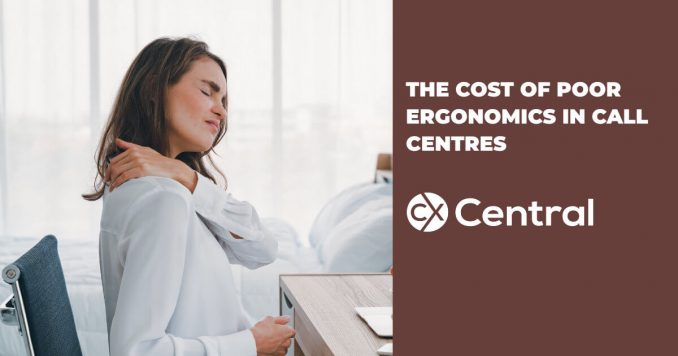
When you think ‘ergonomics’, do you visualise a mouse or someone adjusting their chair? Or maybe think it’s time to check your agents have completed an ergo checklist – the same checklist they completed last year, and the year before that, and maybe the year before that!
Then it might be time for an ergonomics training update.
Today’s work options are increasingly complex. Call centre agents no longer sit at one dedicated workstation. They telecommute, hot-desk, use sit-stand workstations, have multiple screens and keep mobile phones at their desk.
Most office ergonomics checklists are not designed to cover all the new work options, and how can a regular workplace assessment include home offices or the use of laptops during meetings? Is it reasonable to expect a single workstation assessment will resolve all the issues faced by a call centre agent experiencing increasing work-related pain, especially when poor work routines may be the cause?
CX Managers are right to be concerned about increasing levels of discomfort among call centre agents and the effect on absenteeism, presenteeism and productivity.
Prof Alan Hedge, director of the Human Factors and Ergonomics Laboratory at Cornell University, explains that at least 80% of employees in offices, call centres and similar settings report aches, pains and musculoskeletal discomforts related to work. My PhD research revealed that over 11% of call centre agents experience chronic pain every day and those levels and associated costs remain largely unrecognised.
The cost of poor ergonomics in call centres
Chronic pain costs the Australian economy $55 Billion a year and of that $7 Billion in lost productivity, before accounting for any other associated expenses. Currently, the Australia workforce is just below 13 million, so on average chronic pain costs around $540 in lost productivity per employee, and that is just one of many health issues businesses are dealing with every day.
Can your call centre afford to lose $540 from their bottom line for every agent?
Our twenty-first-century workforce faces unique challenges, the consequences of which are only just now being revealed. Even with the most ergonomically sound furniture and equipment available and managers supporting teams through engagement and wellness programs, work-related pain, stress, chronic illness and musculoskeletal disorders (MSD’s) are on the rise.
A recent call for help: “My daughter (24) and her boyfriend (25) are both seeing chiros and doctors for RSI related injuries due to excessive computer use. His is particularly bad leaving his right hand almost useless at the moment, and he is seeking a work cover claim. Being so young, I worry for what his prospects are for his next 40 years of work…”
These stories are increasingly common among my clients.
A new way to focus on ergonomics
It’s time to re-imagine WHS programs and look holistically at workplace wellness because screens are now an integral part of our work and leisure, and the new health risk associated with high screen use and increasingly sedentary work and lifestyle directly affect work performance, work costs and business profitability.
It’s time to think beyond the traditional approach of ergonomics talks, checklists, workstation assessments and workplace audits and consider the new work skills agents need. It’s time to implement training that builds each agents self-care competencies that allow them to take greater personal control and responsibility for their health, safety and wellness at work.
By shifting our thinking about ergonomics from a safety control to include wellness skills, we broaden our mindset about the risks a company must try to control (but find increasingly hard to control) to include enabling and empowering call centre agents to implement personal risk management strategies.
Training that builds agents ergonomic and self-care competencies expands our vision of what is truly possible for workplace health, safety, wellness and injury prevention.
By building simple ergonomics and self-care competencies, your call centre agents will be happier, healthier and more productive. These are strategies that add very little expense to your budget but will help bring down absenteeism, stress, presenteeism, and use of EAP’s, which all means a decrease in your direct costs.
What is your next step to bridging the gap between providing ergonomics information and training that builds call centre agents ergonomic and self-care competencies?


Be the first to comment